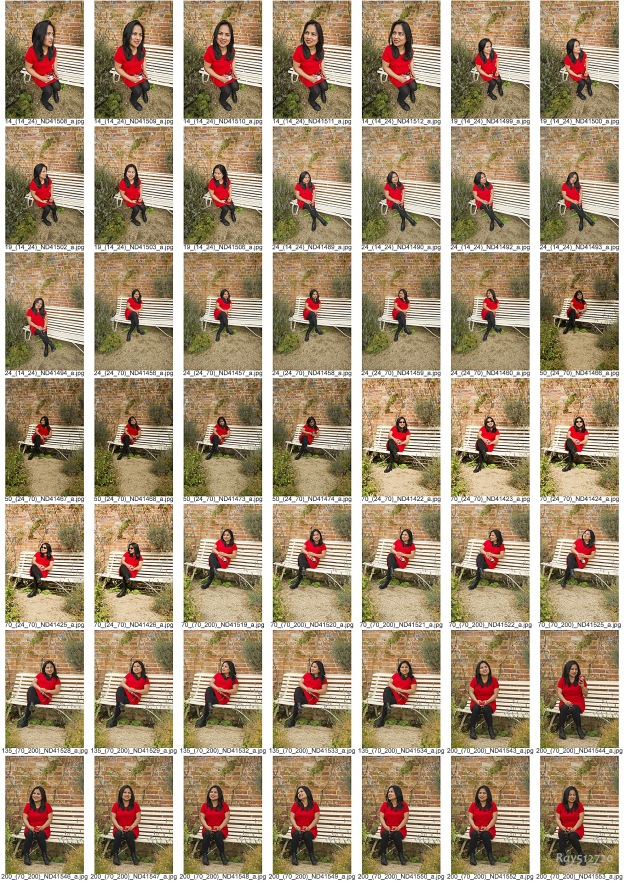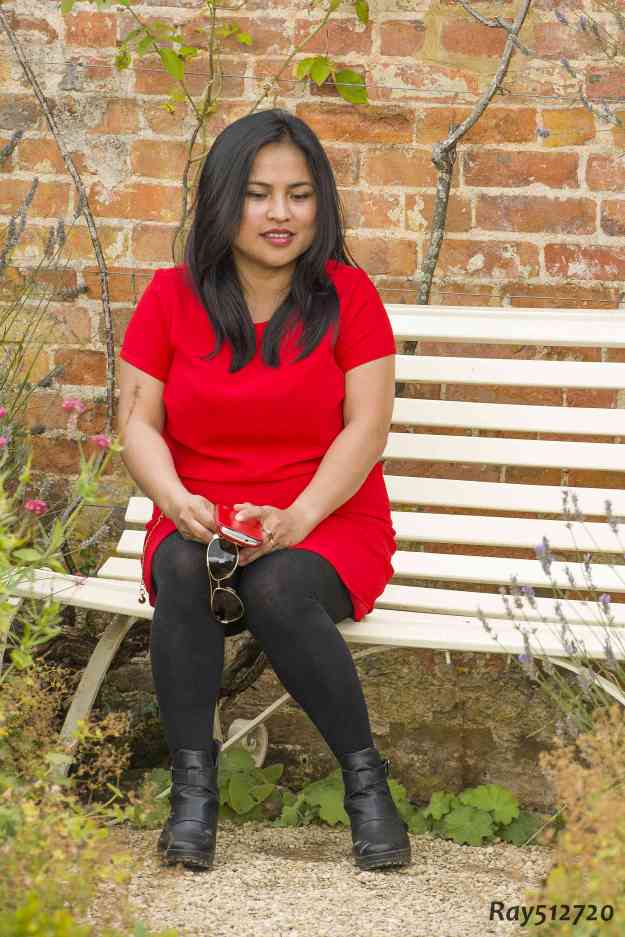Even though you will already have been using a variety of focal lengths to suit different settings and to crop in on the face, or head and shoulders, in this exercise plan to make exactly the same framing on a face with different focal lengths. With a zoom lens, use at least three: at either end of the zoom scale and in the middle. If you have more than one lens, use that, too. You will need to move the camera towards and away from your subject to keep the framing consistent.
Examine the results. The proportions will be different, and in general, the longer the focal length, the more attractive the face will appear. Note your own judgement of the differences according to how attractive or acceptable you think the results look.
– – – – – – – – – – – – – – – – – – – – – – – – – – – – – – – – – – – – – – – – – – – – – – – – – – –
Equipment
Camera – Nikon D4
Lenses – 14/24 (f2.8) _ 24/70 (f2.8) _ 70/200 (f2.8)
Ancillary Equipment – Tripod & Remote Trigger
Method & Approach
Please see pictures and captions below.
Note – all pictures have been compressed hence there might be a quality reduction when enlarging.
Shown in this sequence are some of the pictures taken from this shoot, utilising three different lenses.
- Nikon – 14/24 (f2.8)
- Nikon – 24/70 (f2.8)
- Nikon – 70/200 (f2.8)
Each lens was used at three different focal lengths, full focal length, half focal length and minimum focal length.
Comments on this sequence
1. Nikon – 14/24 (f2.8)
The first fifteen pictures shown in this sequence were taken using the 14/24 wide angle lens and as we can see from the results, this type of lens does not promote or flatter the model. Instead the resultant images are distorted due to the nature in the way that this lens works.
Pictures one to five (focal length 14mm) – Are the most distorted visually making my wife’s head and upper body out of proportion to the rest of her body.
Pictures six to ten (focal length 19mm) – Adjusting the focal length and also moving the camera away from the subject in this situation has produced a similar characteristic to that of pictures one to five but slightly less exaggerated.
Pictures eleven to fifteen (focal length 24mm) – Again after recomposing the camera and focal distance has produced images more in keeping with true perspective but in relevance to camera position (just over one meter away) it was very uncomfortable for the subject with such close-up and confined photography.
2. Nikon – 24/70 (f2.8)
Pictures sixteen to twenty (focal length 24mm) – Although this is a different lens the settings are a continuation from the last lens used. I have recomposed the picture slightly by moving the camera further away from the subject (more than two metres) and we can see the subject is much more at ease. As for the images created from this lens the subject appears much more to scale.
Pictures twenty one to twenty five (focal length 50mm) – Recomposing the cameras distance to shoot at fifty millimetres (focal length) has produced a visual similarity to that of twenty four millimetres with this lens.
Pictures twenty six to thirty (focal length 70mm) – Upon setting the camera and lens combination to a focal distance of seventy millimetres and again repositioning the tripod in accordance to the previous pictures, has produced a much more balanced picture. The scale of the subject and surrounding details are much more in keeping with a more natural perspective.
3. Nikon – 70/200 (f2.8)
Pictures thirty one to thirty five (focal length 70mm) – Like with the previous lens swap this is a continuation of lens settings from the last lens used. Again moving the tripod to a new position has created a very similar perspective to the pictures above (24/70 @ 70mm).
Pictures thirty six to forty (focal length 135mm) – At a focal distance of one hundred and thirty five millimetres we can really see a difference of picture characteristics and the subject is no longer agitated from an overcrowding of camera and lens proximity. With the subject more at ease the body language has improved dramatically and in relevance to lens choice and focal length, the image properties are very much in keeping with true scale and perspective.
Pictures forty one to forty nine (focal length 200mm) – I decided to shoot and also included pictures from this lens at this focal length (two hundred millimetres). I know this lens very well from past experience and as we can see the results are very similar to those of the previous lens settings but better as the body language has further improved due to the subject being even more comfortable at this shooting distance (approx. five meters).
My picture of choice
Camera Details
Camera Nikon D4 (Camera positioned on a tripod)
Speed 1/60th sec
Aperture f8.0
ISO 100
White Balance Setting 5500°K
Lens 70/200 – f2.8 lens
Focal Length 200mm
Comments – I have chosen this as my first picture of choice as I like the candid look of capture and the innocence of body language. The picture characteristics are also in keeping with scale and the perspective angle suggests a friendly nature with her arms slightly open, not folded.
What have I learnt from this exercise
Even though I religiously look at each picture on the back of the camera after each shot this exercise has taught me to only make final considerations after looking at all and each of the pictures on the big screen. Whilst composing the subject during the shoot the camera screen gives a brief verdict of body language, picture character and composition, as well as colour, image balance … which is all very good but as mentioned above a true verdict is only obtained from looking at the picture on the big screen (computer).
Thoughts and Reflection
I had thought long and hard about a location for this shoot, I personally didn’t want to be in the way of other people neither did I want to be rushed due to an area or location of popularity. I also wanted a time of day for access and a fairly neutral back ground without too much distraction. I had written down several regular locations and gardens I visit, I even consulted my library of personal pictures from previous shoots and finally after seeing and remembering a particular quiet part of a garden in a stately home (open to the public) I made my decision. The location I had chosen is called Rousham located in Oxfordshire (on the way to Banbury) and after two days waiting on the weather, I finally packed my bag, decided my wife should wear red and set off.
Due to schools returning and early morning arrival time both me and my wife paid our entrance, set up the kit and continued to shoot for the best part of forty minutes without seeing or hearing a soul ‘perfect’ the shoot had gone well, with the sun only occasionally disappearing behind cloud.
So … my thoughts and reflection upon this exercise is basically a summery of above, where it pays huge dividends upon planning a shoot and to also take time in choosing a location that suit the type of mood you like to shoot in. For me that is … unrushed, quiet, not too popular (my choice here was to get there early on a less popular weekday) and to keep an eye on the weather. If the location in mind has an entrance fee there is will be information about opening and closing times or even a website.
Summary
I took my time in choosing this particular location and I believe it paid off. This in tail made for a much more enjoyable shoot and relaxed experience upon both me and my wife (my model).
Additional
With regards to the nature of this exercise in understanding lens characteristics and their effect on people, I have scanned three examples with explanation taken from a book I read recently.
Book title – Collins Complete Photography Course
By – John Garrett & Graeme Harris
ISBN – 978-0-00-727992-0




